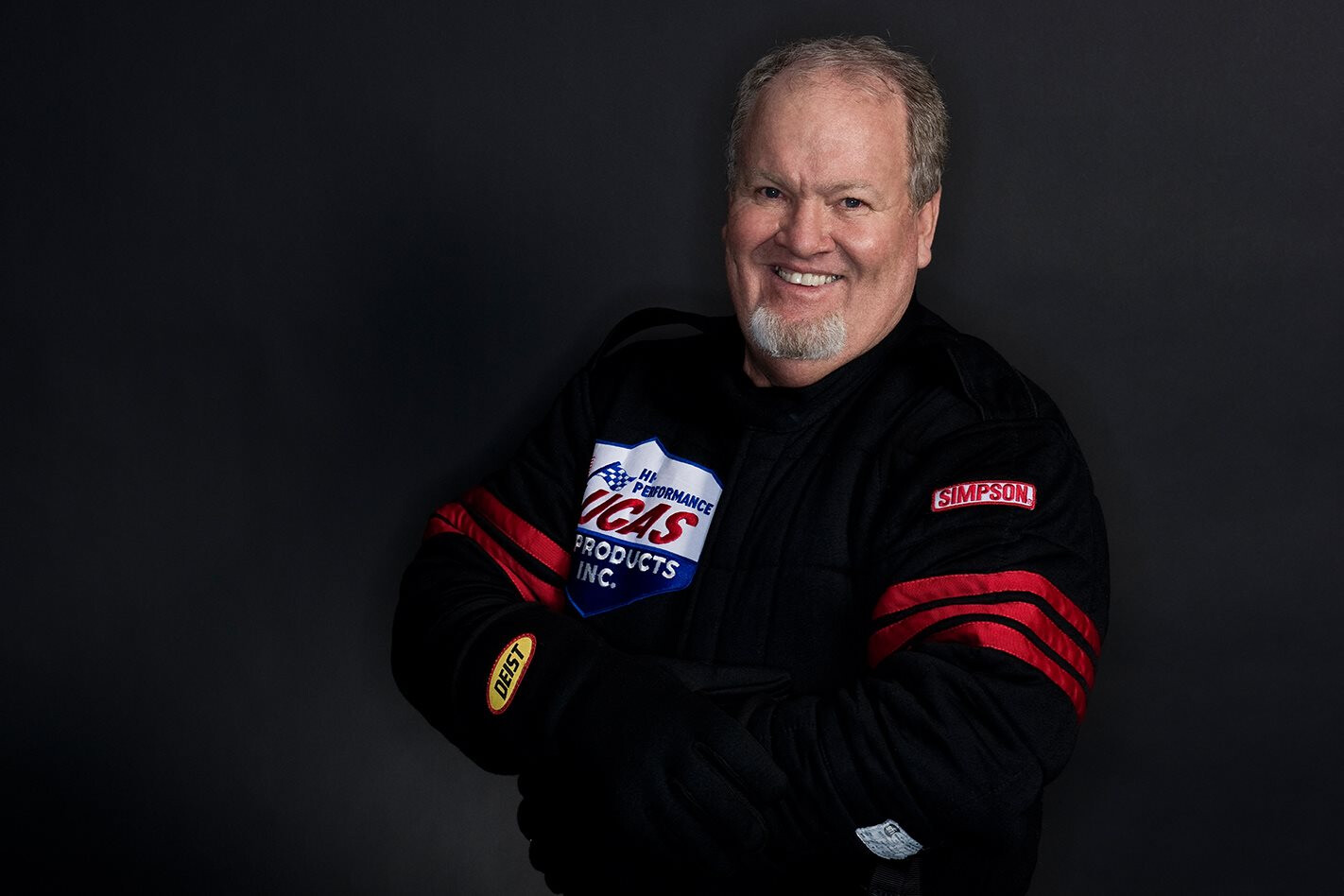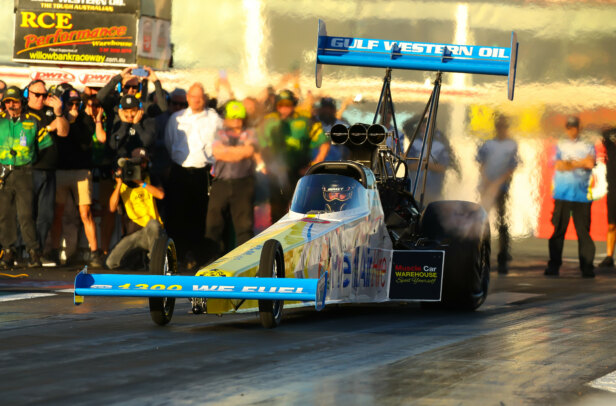Drag racer Gary Phillips has been breaking records, winning championships and generally setting the standard for decades. Back in 2010, we spoke with Gary as he was about to mark his 40th season of drag racing, with an impressive 15 national titles under his belt.
This article on Gary Phillips was originally published in the August 2010 issue of Street Machine
Just as Jim Read is synonymous with Top Fuel in Australia, Gary Phillips is the man in Top Alcohol. And with the 2009/10 ANDRA season adding yet another Top Alcohol title to his impressive string of victories there’s no sign of him slowing down.
You’ve won 15 Australian titles in total — are you still hungry?
Winning doesn’t get old. I don’t get complacent; complacency is not one of my traits [laughs].
What did you start racing in?
My street car — an EH Holden. Then I stepped up to a Ford Y-block powered altered and then a Holden six-cylinder FED. You look back, and you wouldn’t drive some of that stuff on a bet now. You wouldn’t get in them on jack stands. You think about what you got away with and how lucky you were.
What was your first really quick car?
A direct-drive BB/Dragster, powered by an iron-block 392 Hemi and 6/71. It ran a 7.70 at 190mph or so.
Is that when the Yanks started to take notice?
Marc Danekas toured Australia in 1980, match-racing with Marvin Graham. Marc offered me a job crewing for him back in the States. I was in my mid-20s and single at the time, so I jumped at the chance. I spent the ’81 season crewing for them and they finished third in the NHRA Top Fuel championship.
What was that experience like?
There were only three of us working on that car. Back then it was 100 per cent nitro and two-speed transmissions — 5.60@250mph was a killer run. Now we make more horsepower on alcohol than we did on nitro back in those days.
You also crewed with Jim Read in the US.
Yep, it was Jim, Russell Jones and me. Jim qualified number one and set a new track record with a 5.69sec pass at the 1982 Winternationals in Pomona, California. Unfortunately, he went out first round but we certainly had the Yanks talking.
When did you get a chance to drive over there?
I headed back to the States in ’86 for more crew work which eventually led to a drive in Bill Dunlap’s Nitro Funny Car running NHRA, IHRA and AHRA.
You suffered a massive crash at the ’86 NHRA Springnationals, right?
It was black Friday [laughs] — Friday 13th of June it was. That was a crew malfunction; they burnt a piston and never tightened up the rocker cover and it blew the gaskets out. I didn’t get hurt — I burnt my little finger and moustache, that was about it. If you can’t be fast, be spectacular! I think Debbie was more concerned than me. We weren’t married at that stage. She was standing on the start line and all she could see was the fibreglass on fire.
So you were straight back into it?
I came back with another funny car and did match-racing in Oz and New Zealand. When Top Alcohol became an official Group One ANDRA bracket, I had a go and won my first couple of Aussie Championships in ’91 and ’92.
What changed for you after that?
That’s when I started to get serious about it. I had reasonable equipment and reasonable cars. On top of that, I’d just gotten a lot more experience and that’s when the winning started.
When did you get back into the dragsters?
I bought a new dragster chassis after crashing and destroying my funny car at Willowbank in ’92. That one could have been nasty. I shook the tyres and hit the guardrail. It jammed the throttle open and it went across the track the other way and ended up over the top of the guardrail. The dragster was a good car — it ran the first five-second Top Alcohol pass and won a lot of races.
So why did you make the move back into racing the funny car in 2007?
I needed a new challenge and with the funny car thing I thought there were better opportunities for Lucas Oil products with signage space. Plus there was a performance barrier there that I thought was attainable. And we proved that by setting both ends of the record — but I still think we can go quicker.
What is it like running the Doorslammer on top of the Alcohol car?
Doing the two-car thing is hard but it’s sort of worked out. I needed an outlet, though, because there weren’t as many rounds for Top Alcohol and I still had to service Lucas Oils, so it was easier to do that just to keep the sponsor happy. Plus it was a challenge and interesting to see how we’d end up going over there.
You’re a professional drag racer now but what did you used to do for a job?
Well I’ve had 40-something jobs and the reason I’ve had that many is because I used to want time off to go racing and they wouldn’t give it to me, so I’d quit. Then I’d come back and I’d have to get another job. I started off as an apprentice radio and TV technician. It was hard — I’d be at a job for a couple months and I’d want time off and they’d say: “No, you haven’t been here long enough,” and I’d say: “See ya!” One day I’d be a mechanic, the next day I’d be a fitter or a plumber, and to this day I’ve never been asked for a certificate.
You’ve said that you’re more mechanically minded than driver orientated — is there any interest in handing off the driving duties to your son, Cheyne?
Well he’s champing at the bit and he’s 20 but my deal with him was go to uni and do business finance and all that. I said: “You can race forever but get a career first and then we’ll talk about it.”
How hard is it to stay at the top of the field?
It’s hard to win the first one [championship] but it’s even harder to stay there. It keeps you driven, I think, when you get to the top of the ladder and there’re 20 guys trying to knock you off the top. When you’re up there, there’s only room for one. I just try and race me; I don’t race the other guy, I just race my lane.
It’s a real family deal for you guys, isn’t it?
Oh it is — we do 99 per cent of the work here. I’ve just got a home workshop. I haven’t got a flash shed. I always say that to guys; I don’t race sheds or trailers — I race with the race car. Deb is the backbone of it all, she’s as keen as I am. It gets harder as you get older and all that stuff but we don’t surround ourselves with a cast of 1000s because the quality control goes out the door, so we do everything ourselves. The logistics of it is better when you have some control over it. I’m probably trying to do too much, with tuning, paying the bills and driving but I’m pedantic about quality control — there is no second-best otherwise it doesn’t go down the track. The buck stops with me.
1. Gary’s Holden six-powered D/Dragster broke the national record five times, with an Amos-injected 192, Duggan head and clutched TorqueFlite.
2. During the early to mid-80s Gary held records in AA/D (dragster), AA/FC (funny car), and AA/A (altered) – during one period he held seven national records at once.
3. The Lucas Chev Monte Carlo funny car has taken Gary to back-to-back Top Alcohol titles and reset both ends of the record — 5.524sec and 260.71mph.
4. Somehow Gary and his small team have managed to run both the funny car and the Doorslammer at most big events since 2000, taking out the ’Slammer title in 2006/7.





Comments